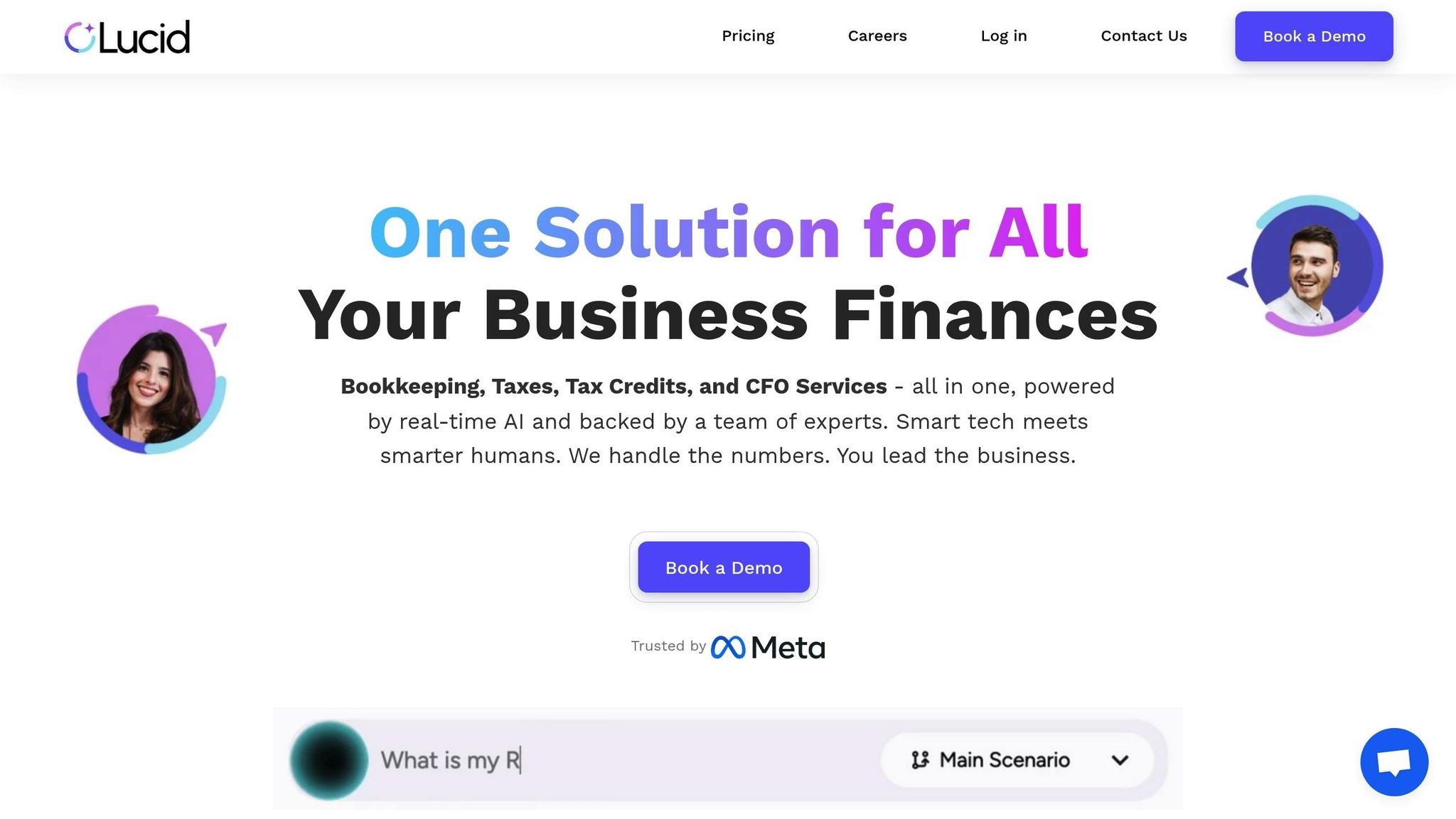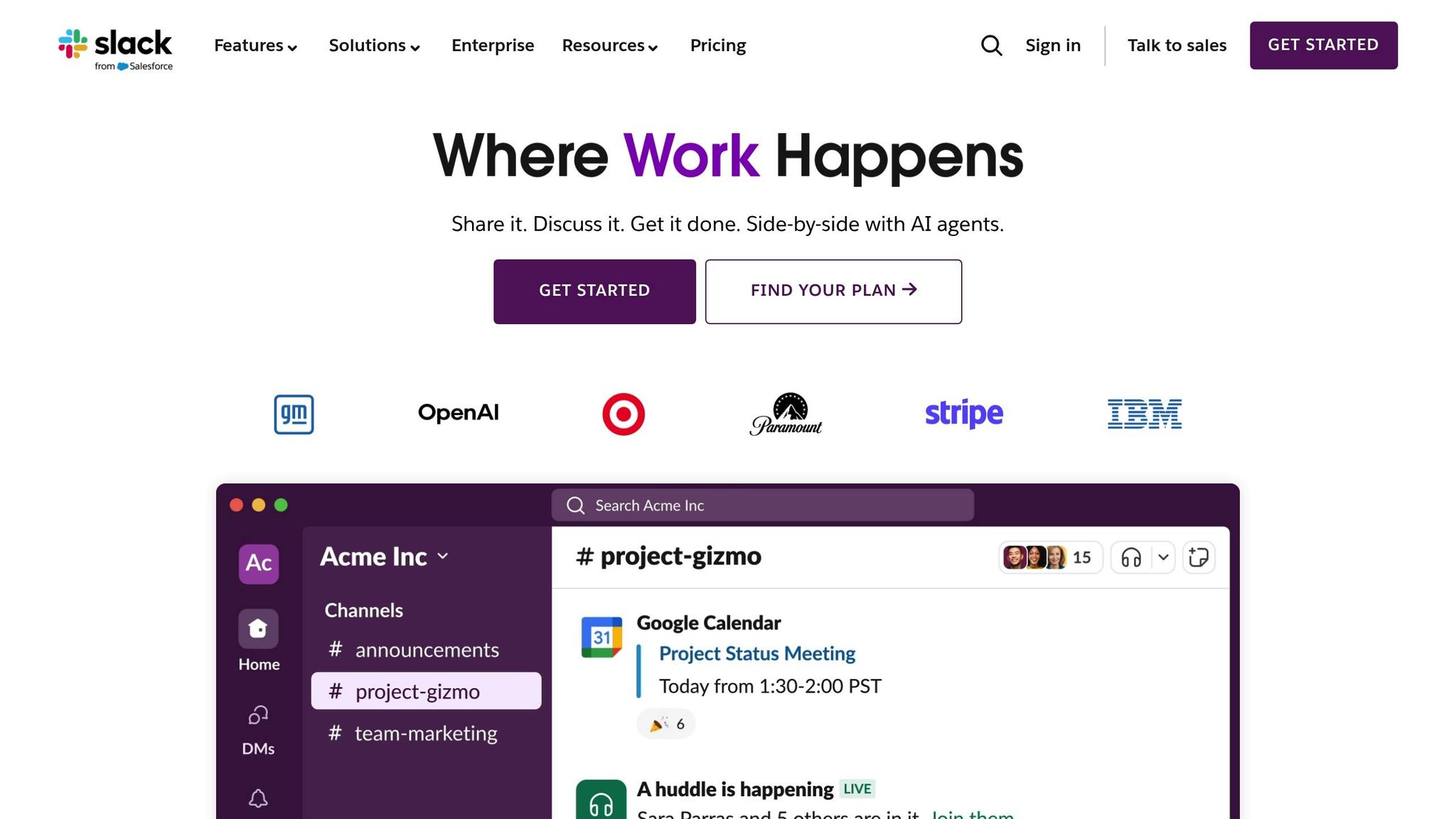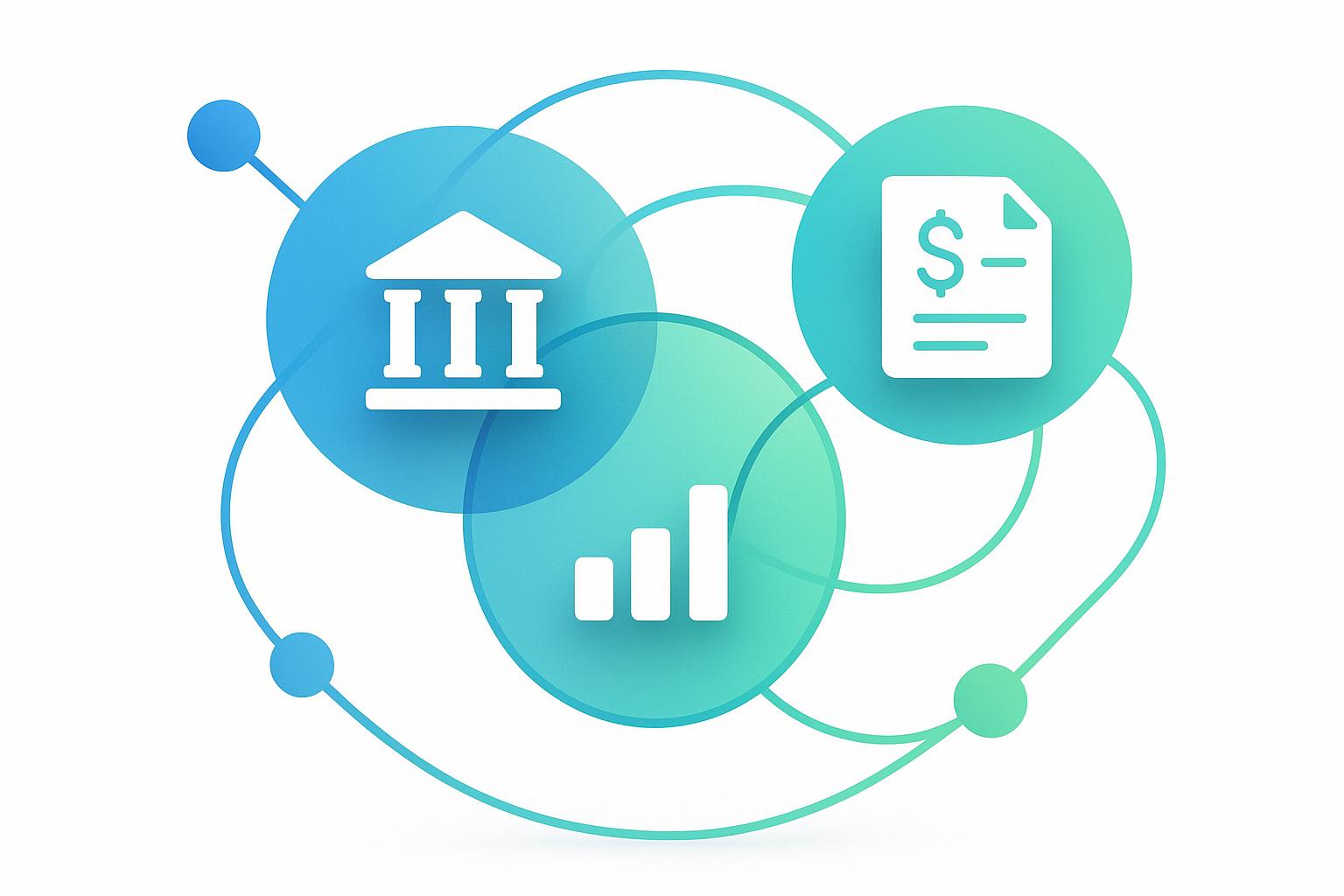AI scenario planning helps startups make smarter financial decisions by analyzing data in real-time and creating dynamic forecasts. Unlike static spreadsheets, this method accounts for rapid market changes, giving startups the tools to plan for multiple outcomes - whether best, worst, or somewhere in between. Here's why it matters:
- Real-time updates: AI adjusts forecasts instantly as new data comes in, keeping projections accurate.
- Risk detection: Identifies potential issues like cash flow problems or customer churn early.
- Simplified modeling: Automates "what-if" scenarios, saving time and effort.
To implement it effectively:
- Clean and organize your data (financial, operational, market).
- Identify key drivers like revenue, costs, and external factors.
- Build and refine scenarios regularly using AI tools.
Platforms like Lucid Financials streamline this process, offering AI-powered insights, Slack integration, and investor-ready reporting. Starting at $150/month, it simplifies financial management while enabling startups to plan effectively for growth.
Raise funding faster - AI builds financial model for your startup or business
Key Benefits of AI Scenario Planning
AI scenario planning equips startups with systems capable of adapting to shifting conditions while delivering actionable insights. Below, we delve into the standout advantages of this approach.
Real-Time Forecasting and Updates
Traditional financial models often struggle to keep up with rapid market changes, becoming outdated as new data emerges. AI scenario planning solves this problem by continuously processing live data to refine forecasts. When market conditions shift - whether due to economic changes, industry trends, or unexpected events - AI systems adjust projections instantly. By analyzing data from sources like sales metrics, website activity, industry developments, and broader economic indicators, these tools ensure financial projections remain relevant and accurate. This real-time adaptability is especially crucial for startups operating in fast-paced industries, where quick, informed decisions can make all the difference.
Enhanced Risk Detection and Prevention
AI brings a sharp eye to financial planning, spotting patterns that manual methods might miss. It provides early warnings for potential issues such as cash flow problems, customer attrition, or inefficiencies in operations. For instance, subtle drops in customer engagement might hint at future revenue challenges, allowing businesses to implement retention strategies before the situation escalates. Additionally, by factoring in external risks - like economic trends, competitor movements, and broader industry signals - AI scenario planning delivers a well-rounded risk assessment. This helps startups tackle potential obstacles proactively rather than reactively.
Simplified Complex Modeling
Manually creating multiple financial scenarios is not just time-consuming but also resource-heavy. AI takes over this burden, automating the generation of diverse scenarios based on critical business variables. This automation empowers founders to explore "what-if" situations quickly, uncovering insights that lead to smarter, more strategic decisions. By saving time and effort, startups can focus on refining their strategies rather than getting bogged down in labor-intensive modeling.
How to Implement AI Scenario Planning
AI scenario planning can transform your financial strategy by turning raw data into actionable insights. To make it work effectively, you need a structured approach that builds on three key phases: cleaning and preparing your data, identifying critical business drivers, and creating dynamic scenarios. Each step is essential to building a strong foundation for strategic planning.
Prepare and Clean Your Data
Your data is the backbone of AI scenario planning - if it’s messy or incomplete, even the smartest AI models won’t deliver reliable results. Start by gathering all relevant financial, operational, and market data from your business records.
- Financial data: This includes historical revenue, expenses, cash flow statements, and any forecasts you’ve already created. These figures provide a clear picture of your startup’s financial trends.
- Operational data: Think about metrics like customer acquisition costs, churn rates, inventory levels, and employee productivity. These numbers reveal how efficiently your business operates.
- Market data: Industry benchmarks, competitor analyses, economic indicators, and customer behavior patterns all fall into this category. They help you understand the external factors shaping your business environment.
Once you’ve collected your data, clean it. Fix inconsistencies, fill in missing information, and standardize formats (like using the same currency symbols or date styles). Then, validate your data by cross-checking it across different sources. For example, make sure the sales figures in your CRM align with the revenue numbers in your accounting system. This step is critical to avoid errors that could derail your planning later on.
Identify Key Business Drivers and Variables
With a clean dataset, the next step is to determine what truly drives your financial outcomes. These drivers can vary depending on your industry or the stage of your business, but they generally fall into a few common categories.
- Revenue drivers: Factors like customer acquisition, pricing strategies, and market penetration can heavily influence your cash flow.
- Cost drivers: Staffing, marketing budgets, and operational overhead are all key contributors to profitability.
- External factors: These include things like interest rates, inflation, regulatory changes, and industry trends. While you can’t control these, they still play a major role in shaping your business outcomes.
Document how these variables interact with your financial performance. For instance, if you increase your marketing spend by 10%, how does that impact customer acquisition? Or, how do seasonal trends affect your monthly revenue? These relationships are the building blocks for your AI models and will help you create meaningful scenarios.
Build, Analyze, and Refine Scenarios
Now it’s time to put everything together and build scenarios that reflect possible futures for your business. A good starting point is to create three types of scenarios: base (most likely), optimistic (best-case), and pessimistic (worst-case). Use your historical data and industry benchmarks to set realistic assumptions for each one.
- Base case: This scenario represents what you expect to happen under current conditions.
- Optimistic case: Here, you model what happens if key variables perform better than expected.
- Pessimistic case: This scenario prepares you for challenges like slower growth, rising costs, or worsening market conditions.
AI tools can help you model how these variables interact and update your scenarios as new data becomes available. Refining your scenarios is an ongoing process. Regularly compare your predictions to actual results and tweak your models to improve accuracy. Over time, this iterative approach will make your forecasts more precise.
To get the most out of your scenarios, involve key stakeholders from finance, operations, and strategic planning in regular review sessions. Use these meetings to discuss the potential impact of each scenario, identify next steps, and update assumptions based on the latest business developments or market insights.
sbb-itb-17e8ec9
Using Lucid Financials for AI Scenario Planning

When it comes to dynamic scenario modeling, having the right tools can make all the difference. A well-designed platform simplifies the process while offering advanced capabilities, and Lucid Financials does just that. With AI-driven features tailored for startups, Lucid Financials transforms financial planning into a seamless, data-informed process, helping businesses make quicker and smarter decisions.
AI-Powered Financial Insights
Lucid Financials takes raw data and turns it into practical, scenario-based insights. By analyzing historical data, key metrics, and market trends, the platform automatically generates forecasts that adapt to your business. It provides real-time projections for best, worst, and base-case scenarios, ensuring your plans stay relevant as conditions change. On top of that, Lucid offers instant insights into critical metrics like burn rate and runway while incorporating industry benchmarks to validate your financial assumptions against market realities.
Slack Integration for Instant Support

Lucid Financials goes beyond traditional dashboards by integrating directly with Slack, offering instant, data-backed insights at your fingertips. Need to analyze a specific scenario? Just ask in Slack, and Lucid will provide immediate feedback. You’ll also receive alerts when critical thresholds are reached, keeping you informed of any significant changes.
"Lucid has made it incredibly easy to track spending, plan ahead, and handle our growth. It's straightforward and effective."
– Aviv Farhi, Founder and CEO @Showcase
For more complex financial decisions, Lucid’s team of finance experts is available through the same Slack interface. This combination of automated insights and expert guidance ensures you're always equipped to make informed choices, no matter the challenge.
Fast and Complete Financial Management
Accurate and up-to-date financial data is essential for effective scenario planning. Lucid Financials ensures your books are clean and ready within just seven days, automating tasks like transaction matching, reconciliation, and reporting. The platform seamlessly connects with tools like QuickBooks, payroll systems, and banks, keeping your financial data current and organized. Plus, with a single click, you can generate investor-ready reports - perfect for board meetings or investor updates.
Lucid’s transparent pricing starts at $150 per month, making it an affordable option for startups while scaling to meet growing needs. By streamlining financial management and offering powerful scenario planning tools, Lucid Financials empowers businesses to stay proactive and confidently navigate their growth journey.
Best Practices and Common Mistakes in AI Scenario Planning
Effective AI scenario planning isn't just about having the right software or tools. It's about using those tools wisely, following proven strategies, and steering clear of common errors that can undermine your efforts. Here's what startup founders need to know to make the most of their AI scenario planning.
Monitor Data Quality and Model Performance
The accuracy of your AI scenario planning is only as good as the quality of the data it relies on. Poor data leads to misleading forecasts, which can send your startup down the wrong path. Clean and reliable financial data is the cornerstone of dependable scenario modeling.
- Validate your data: Set up processes to catch duplicates, missing entries, and inconsistencies before they become an issue.
- Automate alerts: Use automated systems to flag unusual patterns, like unexpected spikes in expenses or revenue.
To measure how well your models are performing, track metrics like Mean Absolute Percentage Error (MAPE) and Root Mean Square Error (RMSE). A MAPE under 10% indicates strong accuracy, while anything over 20% signals that your model needs adjustments.
It's also crucial to keep your models up to date. A model trained on data from your pre-product-market-fit days won't give you accurate results once you've reached post-PMF. Schedule monthly reviews to ensure your model assumptions align with your current business stage and goals.
Create Multiple Scenarios for Better Preparation
Once your data and models are solid, expand your planning by preparing for a range of possible outcomes. Relying on just one scenario is risky - startup life is full of surprises, and being caught off guard can be costly. Successful founders build multiple scenarios to cover a variety of possibilities.
Start with three key scenarios:
- Best-case: Optimistic outcomes like faster customer acquisition, successful fundraising, or favorable market trends.
- Base-case: The most likely scenario based on current data and market conditions.
- Worst-case: Challenges like economic downturns, tough competition, or slower-than-expected growth.
For major decisions, go beyond these three. For example, if you're planning to enter a new market, create scenarios that consider different levels of market penetration, potential regulatory hurdles, or competitor reactions. Each scenario should include specific assumptions about critical factors like customer acquisition costs, lifetime value, and market size.
To make these scenarios actionable, assign probability weights to each one based on your current insights and performance. This helps you prioritize resources effectively rather than treating all outcomes as equally likely. Update these probabilities regularly - monthly, if possible - as new information comes in.
Avoid Relying on Static Models
In a fast-moving startup environment, adaptability is essential. One of the biggest mistakes in AI scenario planning is treating your models as "set-it-and-forget-it" tools. Static models quickly become outdated, so it's important to continuously update them with fresh data.
This doesn't mean starting from scratch every month. Instead, focus on integrating new data as it becomes available. Real-time data updates ensure your scenarios reflect current market conditions rather than outdated trends.
For example, a model built during a booming market won't help you navigate an economic slowdown. Similarly, models based on pre-pandemic data left many businesses unprepared for the upheaval of 2020. To avoid these pitfalls, include adaptive feedback loops that adjust your model's parameters when actual results differ significantly from predictions.
Broaden your perspective by incorporating external factors like economic trends, industry shifts, and regulatory updates. Use external data sources to ensure your scenarios account for these larger forces.
The goal is to keep your models flexible without losing sight of the core insights they provide. Over time, your AI scenario planning should become more refined and aligned with your business needs, ensuring it stays relevant and reliable as your startup evolves.
Conclusion: The Business Advantage of AI Scenario Planning
To wrap things up, AI scenario planning is reshaping how startups approach their financial strategies. By turning complex data into actionable insights, it transforms uncertainty into a strategic asset. This method not only supports sustainable growth but also enhances how businesses adapt and plan in an ever-changing market.
Smarter Decisions with AI-Driven Planning
AI-driven scenario planning empowers startups to make sharper, faster decisions by analyzing massive datasets, uncovering hidden trends, and delivering recommendations that align with business goals. This approach ensures that opportunities are seized promptly while minimizing risks.
With AI, forecasting becomes more accurate, and potential financial risks are identified early. This precision is invaluable when making crucial decisions like hiring or presenting to investors. Moreover, the ability to adapt financial strategies in real time - based on continuous feedback and market changes - keeps startups competitive in fast-paced industries.
By automating routine tasks like financial analysis and forecasting, AI allows teams to focus on strategic priorities. This operational efficiency means startups can scale effectively without the need for large finance teams, making growth more cost-effective.
How Lucid Financials Drives Startup Growth
Lucid Financials takes these benefits further by integrating AI scenario planning into everyday operations. Its financial management platform uses AI-powered forecasting to deliver detailed projections and "what-if" scenarios, all based on real-time data. This gives startups the confidence to make informed decisions quickly.
The platform’s Slack integration ensures financial insights are always within reach. Instead of waiting for monthly reports, teams can simply ask about runway, spending trends, or growth scenarios directly in Slack and receive instant, AI-generated answers. This keeps decision-making aligned with the pace of business.
Lucid also simplifies investor relations with its investor-ready reporting. By converting AI-driven scenarios into polished reports, it helps build trust and confidence with stakeholders. Instant access to board-ready forecasts ensures startups are always prepared for fundraising conversations.
On top of that, Lucid offers a full-stack solution, combining bookkeeping, tax services, and CFO-level strategic support. This ensures that every analysis is backed by accurate, up-to-date financial data. With reconciled books and real-time insights, startups can rely on a clear picture of their performance.
Starting at just $150 per month, Lucid makes enterprise-level AI financial planning accessible to startups at any stage. From pre-seed to Series C and beyond, the platform evolves alongside your business, ensuring that your investment in AI-driven planning continues to fuel growth and long-term success. This seamless blend of AI and financial management is the foundation for achieving the kind of agility and foresight that every startup needs to thrive.
FAQs
How is AI-powered scenario planning different from traditional financial modeling for startups?
AI-driven scenario planning brings a fresh approach to financial modeling by focusing on speed, accuracy, and the ability to adjust on the fly. Traditional methods often rely on fixed assumptions and require lengthy, manual data input. In contrast, AI can process massive datasets in real time, offering quicker and more precise insights.
For startups, this means being able to respond swiftly to market shifts, identify potential risks earlier, and evaluate a variety of scenarios without hassle. This approach provides a more responsive and dependable way to make decisions, giving founders an edge in today’s fast-moving business landscape.
What steps should startups follow to successfully use AI for scenario-based financial planning?
To make the most of AI in scenario-based financial planning, startups need to start with accurate, well-organized historical financial data. This data acts as the backbone for creating reliable AI models. Once the data is in place, AI tools can be set up to generate multiple financial scenarios. These scenarios help uncover risks, predict outcomes, and minimize mistakes.
AI also allows startups to simulate different market conditions, giving them the chance to evaluate risks and fine-tune strategies ahead of time. With AI-powered tools, startups can access real-time insights and make data-driven decisions faster. These tools also simplify team collaboration, ensuring everyone stays aligned with financial objectives and strategies.
Using AI for scenario planning not only boosts precision but also helps startups respond to market shifts, allocate resources effectively, and prepare for future challenges with confidence.
How does AI scenario planning help startups manage financial risks and uncertainties?
AI-powered scenario planning helps startups tackle financial risks and uncertainties by simulating various market conditions with speed and precision. This approach enables founders to foresee potential hurdles, assess different outcomes, and take preemptive actions to address risks before they become significant issues.
With AI in the mix, startups can enhance forecasting accuracy, spot risks early, and make smarter, data-backed decisions. This ability to adjust to changing circumstances supports financial stability and positions startups to handle market shifts effectively, allowing them to stay focused on growth and long-term success.


